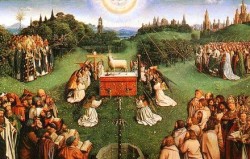
March of 2010 forces a columnist into a predicament. On the one hand, I’d like to talk about Lent — especially since so many have been experiencing a “long Lent” through the economic recession. On the other hand, much of Holy Week also falls in March, and it would seem wrong not to emphasize this most solemn part of the Church’s year.
But it’s really no predicament at all. The two seasons were made for each other, and I discuss them together in my recent book Signs of Life: Forty Catholic Customs and Their Biblical Roots.
Whether it’s Lent or Holy Week when you read this, the focus remains the same. In fact, faith tells us that Easter is always our focus as Christians.
We who speak English suffer a fundamental disorientation when we consider the central mysteries of faith. In most languages, the same word applies to the Jewish Passover as to the Christian feast of Jesus’ resurrection. It is Pascua, Pascha, Pasqua, Pesach. The English name, on the other hand, derives from an ancient German spring festival, about which we know very little today.
Thus the term “Paschal Mystery” doesn’t have quite the same associations for us as it has for others. Yet this mystery, according to the Catechism, “stands at the center” of the Gospel (CCC, n. 571). All the other feasts, all the other mysteries point to the central mystery we celebrate at Easter (CCC, n. 1171).
For Christians, the Paschal Mystery should evoke the ancient Passover, when all the firstborn children of Israel were spared, when the chosen people were liberated from slavery, and when they embarked upon their journey to the promised land. Their deliverance began, in each household, with the sacrifice of a lamb and the smearing of the lamb’s blood on the doorposts. In future generations, Jews would recall those saving events, but would also consider them allegorically, as God’s continued deliverance of his people, out of vice and into virtue.
In the fullness of time, Jesus came as the “Lamb of God” (Jn 1:29). For his disciples he was “Christ, our paschal lamb,” who “has been sacrificed” (1 Cor 5:7). For Christians, the Passover has not been abolished, but rather fulfilled. “Let us, therefore,” said St. Paul, “celebrate the festival, not with the old leaven, the leaven of malice and evil, but with the unleavened bread of sincerity and truth” (1 Cor 5:8).
Raised up in the traditions of Judaism, the first Christians could see both the continuity and discontinuity from the Old Covenant to the New. They still celebrated the festival with unleavened bread, but now the sacrifice was Christ himself, who had made an explicit offering of his body at the Last Supper. It was that moment, that paschal meal, that transformed his execution into a once-for-all sacrifice.
The Old Testament Passover began with Israel’s redemption of the firstborn and liberation from slavery, but it culminated much later with the people’s entrance into the promised land, “a land flowing with milk and honey” (Jos 5:6). Between those events, the tribes wandered in the desert for forty years. Those years were a time of purification, when God purged the Israelites of the residual effects of generations of contact with Egyptian idolatry.
That pattern played itself out in Jesus’ own life. Before he launched his public ministry — inaugurating his kingdom — he fasted and prayed for forty days in the wilderness. He did this even though he was sinless and had no need of purification. His fast was, like his baptism, a model for his disciples to imitate.
So, every year, as we prepare to celebrate Easter, the great feast of the Paschal Mystery, we undergo purification through forty days of desert: the “forty days” of Lent.
The early Church celebrated Easter with special solemnity. In some places, the celebration lasted the entire night, from sundown on Easter Vigil till sunrise on Easter morning. In the course of the liturgy, the Church read selected passages from Scripture that told the story of salvation in rough outline, from creation through the resurrection of Jesus. All of history is caught up now in the great Paschal Mystery.
From ancient times, the Church saw the Christian pilgrimage as a movement from purification to illumination and finally to union with God. These are the stages we mark as we pass through the sacraments of initiation. They trace a pattern that plays itself out from Lent to Easter, over the course of history, and over the course of a lifetime.
We “pass over” from sin through penance to communion as we conform ourselves to the Easter mysteries.
Please reserve a place for the St. Paul Center in your seasonal prayer. We have a special place for you in ours.